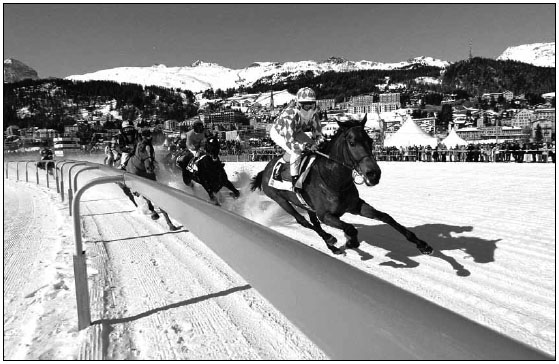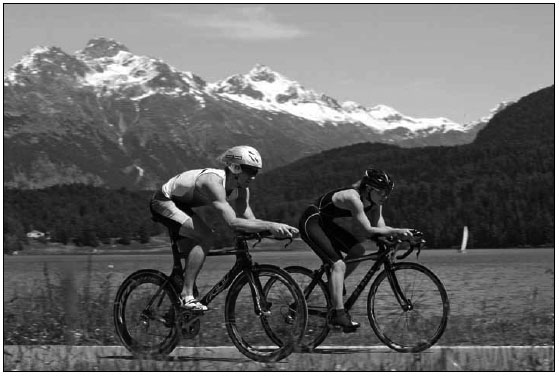“There is no use in altitude training” – but no way!
“There is no use in altitude training” – but no way!
The attack on altitude training was a barrel burst
by Heini Hofmann
We know it from collecting box institutions: sense of mission for the own ambitions can seduce to rewrite things in a way that serves – via tear-jerking and money bag – the donation box. In science sometimes analogical things happen. Such a case concerning the altitude training could have had fatal consequences for the Engadine, the European altitude training centre number one.

Scientific research today first of all is a question of money. Touting for research funds it happens – fortunately only occasionally – even in noble university circles that half-baked “scientific results” are trumpeted.
Making hypothesis to thesis
Research works with posing questions, that means it constructs a hypothesis to then examine if it is in fact as assumed or if it is maybe different. The result of this kind of research is then a thesis. In the past it was usual to go to the media and thereby to the public only with this thesis that means only with the verified scientific result in order not to cause confusion.
However, today it happens more and more that driven by the struggle for research funds, occasionally also to position oneself in the media (malicious gossip speaks about mediahype) one presses ahead already with the hypothesis. And what do most media people do? Of course a thesis out of the hypothesis; because they have to sell their stories crisply with flesh on the bones. Result: The hypothesis being right or wrong is cemented via published opinion as public opinion.
This happened two years ago with the issue of altitude training, induced by a researcher of the University of Zurich who, even during the reviewing process, went full-throatedly public with a previously undisclosed study which was already qualified non valid by other researchers. Of all things he did this via the university information magazine and thereby unnecessarily caused a stir and uncertainty.
“Altitude training does not work”
This destructive statement about an up to then sacrosanct scientific consensus decorated as title an article in the Zurich University periodical magazine where it was described how the concerned scientist emphasised with “ringing laughter” that he had great fun dethroning one of the greatest dogmas of sport physiology, because “our study is simply much better than the others”. The academic cavalry attack was directed at the principle “live high – train low” with which top athletes improve their performance since more than ten years still by some percent.
Responding to Marathon European Champion Victor Röthlin who, like many other athletes, used to do his “Live high – train low” altitude training in the Engadine (living in Muottas Muragl, training in St. Moritz) and who said from his own experience: “three weeks after I come back from the mountains to the lowlands, I literally fly”, the scientist in question answered, that he took the effects of altitude training being perceived by top athletes as positive for a placebo effect, therefore simply for imagination.
Hence, according to his opinion, height would be a placebo that means an ineffective, indifferent substance, a “pseudo-medicament”, administered to patients (i.e. athletes) to answer imaginary needs. An audacious thesis which had had catastrophic consequences for the altitude training Eldorado Engadine. When faced with such a demystification the physician of the century Paracelsus probably would strike back very crude again like he did in those days: “cushion professors…requiem physicians… clowns (‘Gugelfritzen’)… who rumble in the books of the old like sows in the trough”.

Barrel burst instead of flare rocket
The denyer of said altitude training even advised Swiss Olympic to better “hire more psychologists”. Since, “as long as the athletes believe that altitude training is profitable, they will continue to do it”, was his sarcastic motto. Well, he has achieved something, namely media attention, although his study was only one among fifty others (deviating!) For the journals of the yellow press this occasionally is what they are waiting for when university researchers are fighting each other. However, what goes around, comes around. In science this applies, too: The revolution consumes its own children. The alleged flare rocket ended as a barrel burst.
There was harsh criticism in the review process by other well-known researchers that the performance after the altitude stay was not measured at its best time, that the measurement accuracy for the determination of the hemoglobin mass leaves a lot to be desired, that was uncritically interpolated from artificial to natural level. The alleged blank test was not carried out “lege artis” with a high group and a control group, apart from the fact that “the ‘blinding’ during studies of altitude training was nonsense”. The bottom line is what has already been said before. Ultimately, the athletes themselves decide. For them the personal experience counts and this experience is good.
The damage remains done
An analgous case a few years ago comes to mind. It was about the raw milk caseation on the alp. At that time, it was a professor at the ETH Zurich who made such a fuss. It was said to be a threat to life. The majority of the media outbid one another with meeting the trouble halfways to that extend that the Federal Council thought it necessary to appoint a special commission. The latter held meetings, discussed, debated and came to the conclusion that “no immediate measures are necessary.”
To put it plainly, the whole academic kerfuffle was nothing but hot air. The saucy bits of such stories are that a correct position was never and nowhere delivered, note, neither in the case of altitude training. The damage is done and nobody is responsible. For the sake of good order, it should be pointed out that these are always individual cases which, however, also affect the predominantly serious research. •
(Translation Current Concerns)
Racehorses as a trigger
Interestingly, it was not two- but four-legged athletes who opened up the practice of altitude training. After the poor performance of the Swiss delegation at the Olympic Winter Games in Innsbruck in 1964 and with a worried look at the 1968 Olympic Summer Games in Mexico at 2,000 m above sea level, new training methods were required.
The inspiring idea came from St. Moritz; because in the 1920s an interesting observation had been made with racing horses (trotters and galoppers). For the international horse races in February on the frozen lake they came to St. Moritz already one month before for training. At the big spring races in different major European cities they made it to top places. Ergo: These were the first altitude trainings in preparation for competitions at lower altitudes!
The director of the research institute in Magglingen at that time, Professor Gottfried Schönholzer, addressed himself to this phenomenon; because what worked with the hippological training, he concluded, could also be used on human athletes. The future should prove him right.
Not the same for everyone!
“If competitions take place in the height,“ says Jon Peter Wehrlin, specialist in altitude training at the Swiss Federal Institute of Sports in Magglingen, “altitude training for all participants makes sense. In order to achieve the best possible performance, the body has to acclimatise to the high altitude. Compared to ‘normal’ training, altitude training can provide a one to three percent increase in performance. And that‘s exactly what in top-class sport decides between victory or defeat.“
Wehrlin, on the other hand, recommends altitude training as a preparation for a competition in the lowlands only for fully trained athletes, who have already reached a high level with the classic training methods, but with this were not able to achieve more progress. With this additional stimulus, they can improve their performance – individually and tailor-made.
Aim determines method
In spite of a storm in a teacup the following still applies: the original altitude training meant “live high – train high, LHTH”. It serves as preparation for altitude competitions. Besides there is the hypoxia training with “live low – train high, LLTH”. Here the anaerobic performance is improved.
The latest form of altitude training is “live high – train low, LHTL”. “This type of altitude training,” says Jon Peter Wehrlin, head of the Sports physiology (endurance) at the Swiss Federal Institute of Sport Magglingen, SFISM, “has proven to be more beneficial with elite endurance athletes in the preparation for competitions in the lowland than ‘live high – train high’” but also as more beneficial compared to training in the lowlands.
Engadine
• Overnight lodging: Muottas Muragl (2456 m)
or Bernina Hospiz (2309 m)
• Training: St. Moritz (1856 m) and Scuol (1275 m)
Region Davos
• Overnight lodging: Jakobshorn (2590 m),
SLF Weissfluhjoch (2663 m)
• Training: Davos (1540 m) and Klosters (1120 m)
Region Appenzell
• Overnight lodging: Säntis (2501 m)
• Training: Schwägalp (1320 m),
Urnäsch (841 m) or
Herisau (745 m)
Region Central Switzerland
• Overnight lodging: Gütsch ob Andermatt (2344 m)
• Training: Andermatt (1445 m)
Region Valais
• Overnight lodging: Gemmi-Pass, Berghotel Wildstrubel (2346 m)
• Training: Leukerbad (1411 m)